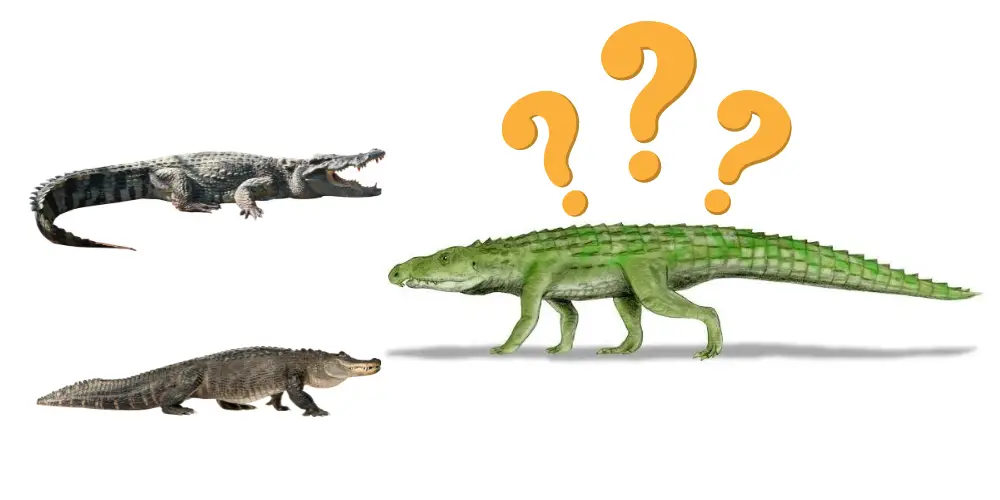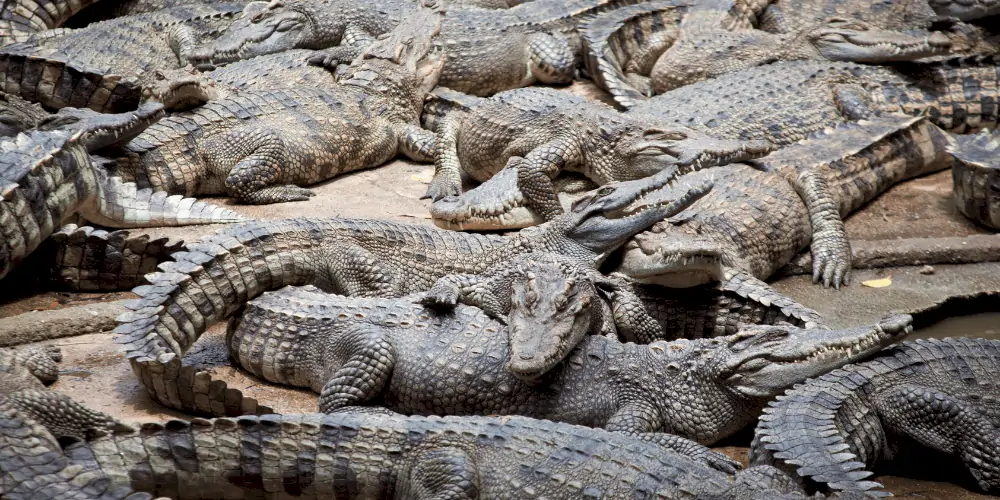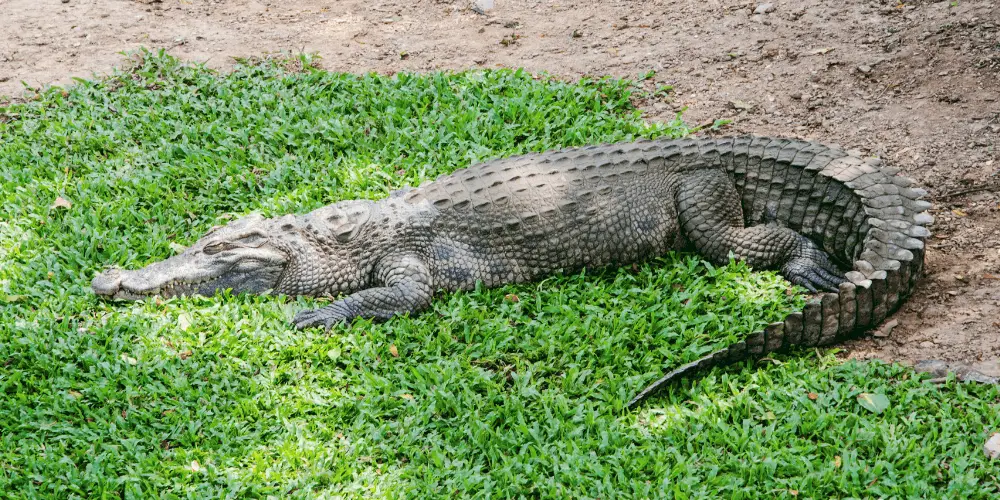Are Crocodiles and Alligators Dinosaurs?” is a question that often arises when people gaze at these powerful reptiles, which appear as remnants of prehistoric times. The answer, however, is:
Crocodiles and alligators are not dinosaurs but share a common ancestry as archosaurs. Crocodiles and alligators differ significantly from true dinosaurs regarding anatomy and behavior. Some key distinctions between these reptiles include their body shape, size, locomotion, and reproductive strategies.
In this article, we’ll delve into the fascinating world of these reptiles and their evolutionary history to explore the connections and distinctions between crocodiles, alligators, and dinosaurs.
Join us as we uncover the complex and captivating story behind these incredible creatures!
Archosaur Ancestry: Linking Crocodiles, Alligators, and Dinosaurs

Although crocodiles and alligators are not dinosaurs, they share a close relationship with them through their common ancestry as archosaurs. Archosaurs are a group of diapsid vertebrates that first appeared in the Late Permian period, nearly 260 million years ago.
This group includes crocodiles, alligators, dinosaurs, modern birds, and extinct pterosaurs. All archosaurs share certain anatomical features, such as antorbital fenestrae (openings in front of their eyes) and teeth set within sockets.
Crocodiles, alligators, and dinosaurs share more than just their ancestry as archosaurs; they also share several physiological and behavioral traits that have allowed them to thrive in their respective environments.
However, it is important to understand that despite these similarities, they are still distinct due to significant differences in anatomy and behavior.
Now that we have established their common ancestry as archosaurs let’s delve into the fascinating world of these reptiles and their evolutionary history to explore the connections and distinctions between crocodiles, alligators, and dinosaurs.
RELATED ARTICLE: Discover the 13 Cutest Dinosaurs of All Time!
Crocodiles, Alligators, & Dinosaurs Evolutionary History

Crocodiles, alligators, and dinosaurs belong to the archosaurs group – a clade of diapsid vertebrates that appeared in the Late Permian period almost 260 million years ago.
Archosaurs And Their Significance
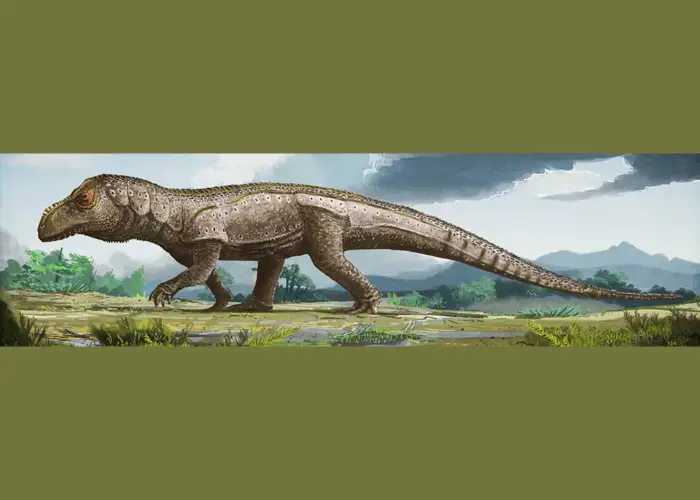
Archosaurs first appeared at the beginning of the Triassic Period. They hold a special place in the evolutionary history of reptiles, as they are the group from which modern crocodiles, alligators, birds, and even extinct dinosaurs emerged.
Often referred to as “ruling reptiles,” their significance extends beyond being ancient ancestors; they represent a diverse array of species with unique adaptations that changed over time.
As an essential link between early reptilian ancestors and many contemporary vertebrates such as birds-, archosaurs’ influence on our ecosystem is unmistakable.
Among their shared characteristics are features such as openings in front of their eyes (antorbital fenestrae) and teeth situated within sockets – traits that allow further classification into distinct subgroups like crocodilians or pterosaurs.
The study of archosaur fossils continues to play a vital role in unraveling our understanding of prehistoric life by revealing new insights into how these impressive creatures adapted and diversified over millennia.
Scientific Classification And Evidence

Crocodiles, alligators, and dinosaurs belong to a larger group of reptiles called archosaurs.
The fossil record provides strong evidence of the existence of dinosaurs during the Mesozoic era, over 65 million years ago.
Today, scientists classify crocodilians under the suborder Eusuchia while classifying dinosaurs in their order Dinosauria. This is because there are significant differences between them regarding anatomy and behavior.
Crocodiles, Alligators & Dinosaurs Similarities
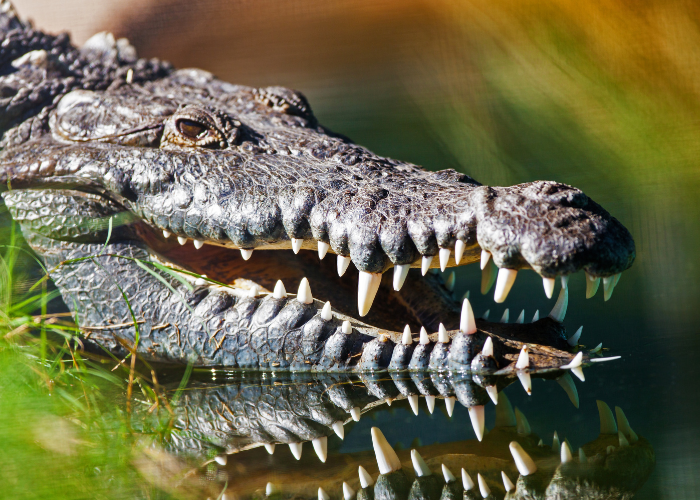
Lifestyle And Habitat
Crocodiles, alligators, and dinosaurs share some similarities in lifestyle and habitat. Firstly, they are all cold-blooded animals that rely on external heat sources to regulate their body temperature.
As such, they tend to be found in warm or tropical regions with abundant sunlight.
Moreover, crocodilians and dinosaurs are known for being apex predators in their respective habitats. They have sharp teeth designed for tearing flesh apart, allowing them to hunt prey much larger than themselves.
The ability to thrive across various environments has allowed both groups to survive catastrophic extinction events throughout history.
Crocodiles, Alligators & Dinosaurs Differences
Anatomy and Behavior

Despite sharing some common features, crocodiles, alligators, and dinosaurs exhibit significant differences in anatomy and behavior. Let’s compare these fascinating creatures in a detailed manner.
| Feature | Dinosaurs | Crocodiles | Alligators |
|---|---|---|---|
| Anatomy | Varied body shapes and sizes, often with specialized features (e.g., long necks, horns, or large claws) | Long, V-shaped snout with sharp teeth, armored, elongated body with a thick, powerful tails | Broader, U-shaped snout with concealed teeth, armored, elongated body with a thick, powerful tail |
| Locomotion | Bipedal (two-legged) or quadrupedal (four-legged), depending on the species | Quadrupedal, with semi-aquatic adaptations like webbed feet and strong swimming ability | Quadrupedal, with semi-aquatic adaptations like webbed feet and strong swimming ability |
| Behavior | Varied, with some species being social, territorial, or migratory, and displaying different hunting techniques | Solitary ambush predators, with some species displaying cooperative hunting behavior | Solitary ambush predators, with some species displaying cooperative hunting behavior |
| Reproduction | Some species laid eggs in nests, while others may have given birth to live young | Lay eggs in mounded nests, with the female guarding the nest and young | Lay eggs in mounded nests, with the female guarding the nest and young |
The Possibility Of Crocodilians As Modern-day Dinosaurs
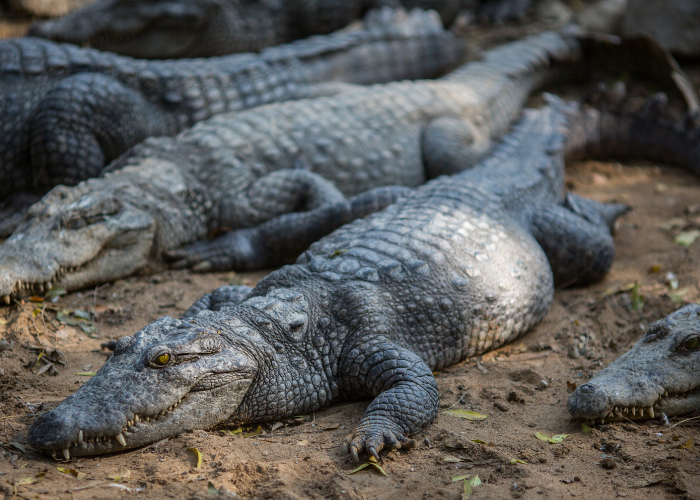
Crocodilia is an order of large, predatory, semiaquatic reptiles known as crocodilians, including crocodiles, alligators and caimans, and the gharials.
This family of reptiles first appeared during the Late Cretaceous Period, around 100 million years ago.
Based on scientific evidence and classification, crocodiles, and alligators are not technically considered dinosaurs. However, some have argued that they could be seen as modern-day descendants of these ancient reptiles due to their similar physical features and behaviors.
Most scientists now view birds as dinosaurs since they share a common ancestor with crocodilians and dinosaurs. As a result, birds and crocodilians are more closely related to each other than to any other existing reptiles like lizards or snakes.
For example, crocodilians and dinosaurs were predators with powerful jaws and sharp teeth.
In popular culture, crocodilians have been depicted as living dinosaurs in movies like Jurassic Park. While this may not be scientifically accurate, it highlights humans’ fascination with prehistoric creatures.
Areas of scientific debate and ongoing research

- The relationship between birds and dinosaurs: One of the most significant debates in paleontology is the relationship between birds and dinosaurs. Over the past few decades, a growing body of evidence has confirmed that birds are descendants of theropod dinosaurs, specifically from the group of maniraptorans. This has led to a paradigm shift in our understanding of dinosaur evolution and has caused some to view birds as modern-day dinosaurs.
- The classification of pterosaurs: Pterosaurs, often called flying reptiles, are another group of archosaurs living alongside dinosaurs. While they share a common ancestry with dinosaurs, crocodiles, and alligators, they are not classified as dinosaurs. There has been some debate over their exact placement within the archosaur tree, and their relationship to other reptile groups remains an area of active research.
- The survival of crocodilians during mass extinctions: Crocodiles and alligators have survived multiple mass extinction events throughout Earth’s history, including the one that wiped out non-avian dinosaurs. The reasons behind their resilience compared to other archosaurs have been a subject of interest and debate among researchers. Some hypotheses suggest that their ability to adapt to different environments, semi-aquatic lifestyle, or low metabolic rates could have contributed to their survival.
- The evolution of crocodilian features: The evolution of certain crocodilian features, such as their armor-like skin and powerful jaw muscles, has sparked discussions among researchers. Some argue that these features evolved in response to their predatory lifestyle, while others suggest they may have been adaptations to specific environmental pressures.
Conclusion:
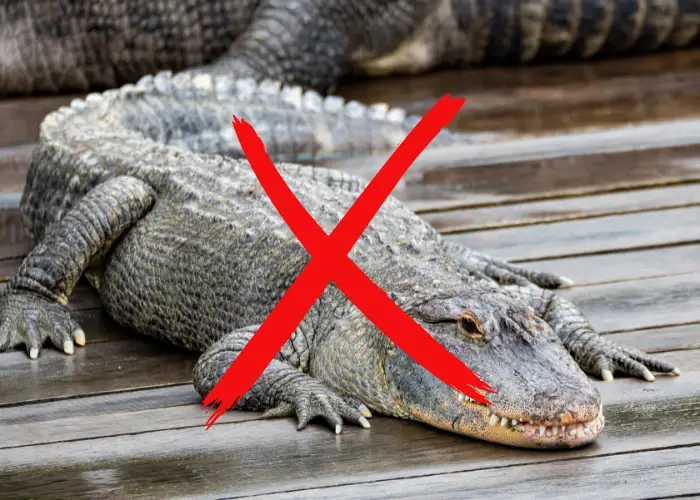
While crocodiles and alligators share many features with dinosaurs, such as archosaurs, they are not considered true or descend from dinosaurs due to significant differences in anatomy and behavior.
Scientific classification and evidence support this claim, but cultural interpretations have led to widespread beliefs that these reptiles are modern-day dinosaurs. Nevertheless, understanding the important roles of crocodilians in modern ecosystems is crucial for maintaining biodiversity and ecological balance.
CHECK OUT MORE CROCS AND GATOR TOPICS BELOW:
REFERENCES:
1. Archosaur. (2023, April 11). In Wikipedia. https://en.wikipedia.org/wiki/Archosaur
2. Evidence for endothermic ancestors of crocodiles at the stem of … (n.d.). Retrieved April 30, 2023, from https://digital.library.adelaide.edu.au/dspace/bitstream/2440/1933/1/hdl1933.pdf
3. A new pseudosuchian archosaur, Mambawakale Ruhuhu the middle triassic manda. (n.d.). Retrieved April 30, 2023, from https://royalsocietypublishing.org/doi/pdf/10.1098/rsos.211622
4. Crocodilia. (2023, April 30). In Wikipedia. https://en.wikipedia.org/wiki/Crocodilia

